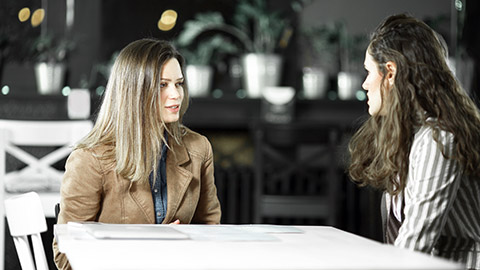Self-reflection is an essential skill for professionals working in the education and care sector. When undertaken regularly and correctly, self-reflection helps you to understand your values and beliefs and how they can affect your co-workers, children, and families. It also helps you to develop a better understanding of yourself and your professional development needs and achievements.
Self-reflection can assist you in identifying and recognising indicators of stress and burnout so that you can seek appropriate help to ensure that you enjoy a productive, long-lived career in your chosen field.
By the end of this topic, you will understand the following:
- How to identify your beliefs and values and how they affect others in your workplace
- How to understand and apply models of self-reflection
- How to identify and act on indicators of stress and burnout
- Your work role boundaries.
Reflective practice supports ongoing professional learning and development by building on educators' strengths and skills and providing deeper understanding of the complexities inherent in their roles and responsibilities. Educators who enact a commitment to reflective practice and taking action make a positive difference to the quality of the education experience and to improving outcomes for children and families.
Anne Kennedy1

Understanding your own values, beliefs, and behaviour is an essential element of cultivating a successful career in the education and care sector – and self-reflection, or reflective practice, is the way to achieve this. Self-reflection requires you to develop the ability to look at your thoughts and actions through a critical thought lens and apply a problem-solving mindset to self-improvement. It demands honest and realistic questioning of what you know and how you can know it.
The way we view the world is coloured by our values and beliefs. No matter how hard we try to be impartial, our morals, ethics, points of view and philosophies influence how we interact with people and behave in different situations.
As a professional in the early childhood education and care sector, you must foster a person-centred practice and develop broad cultural competence. This can be achieved by:
- Challenging and questioning your values, beliefs, cultural understanding, and behaviours, including how they influence your work practice
- Developing skills to learn from your successes and mistakes
- Examining your assumptions about groups of people, including any stereotypes that you harbour
- Learning how to understand and appropriately respond to workplace diversity.
Concept
Stereotypes, which are based on simplified and false beliefs regarding particular groups of people, are widely held. They create narrow and cliqued expectations about all people in that group. The expectations may include predictable actions, personalities, preferences, or abilities of the group of people, creating a limited view. Stereotypes do not consider individual preferences and the uniqueness of every person. For example, Australia has a beach and surfing culture, so a stereotype might be that all Australians can swim.
Reflection
Many of us have had limited experience with people vastly different from us. Sometimes, the only exposure to diverse people and cultures we experience is through media and our recreational viewing habits.
Many television shows and movies rely on stereotypes to create humour and a collective understanding of a certain type of character within the narrative they are communicating. For this activity, sit down to watch some of your favourite television shows with a notepad and pen nearby.
- As you watch, note the stereotypes that you can identify.
- How do these stereotypes make you feel about the people who are being portrayed?
Ensure that you keep notes for future reference, as this information will support your assessment and professional practice.

Self-reflection is a tool that you can apply to improve your practice. Self-reflection allows you to develop an awareness of how these factors influence how you relate to others in the workplace and how they affect those people and your relationships with them. Making a habit of self-reflection can cultivate significant and consistent self-awareness, professionalism, and personal growth.
Self-Reflection Journal
A self-reflection or critical reflection journal is useful for considering your skills development, ongoing professional needs, and actions and outcomes with children, families, and colleagues.
Self-reflection journals must involve consideration of the often intensely emotional and highly confidential nature of early childhood education. That is, a self-reflection journal should always be used in a way that respects children and family confidentiality and the legal and organisational restrictions that apply to recording information.
A self-reflection journal will maintain others' privacy by excluding children, family, and colleagues' names and other identifying features. What will be left should be a record of your thoughts, feelings, and reflections about your work. Journals can allow you to express a range of emotions privately without the need or obligation to censor your thoughts or share them with others.
People with strong emotional intelligence skills often use self-reflection journals. Such people know that understanding and reflecting on your emotions is a crucial step in managing your emotions effectively.
Reading
Read this blog from Reflective Teaching Journal to learn the 14 Reasons Teachers Should Keep a Reflective Journal.
Here is an example of an entry in a self-reflection journal.
I was pleased with my performance in leading the team meeting for the first time today (positive feelings). I felt nervous and anxious (negative feelings), but I made sure that I planned ahead and had the agenda, notepads, pens, and planning spaces ready and that the slideshow was prepared and loaded on the screen. I managed my nerves by focusing on keeping my voice low in pitch and speaking clearly and slowly. I was pleased that I could do this (positive feelings). A few deep breaths helped as well!
Next time, I'll allow more time for introductions and explaining the agenda.
Self-reflection journals are well suited to people with strong literacy skills who enjoy writing and thinking about their experiences. They can also involve a pictorial element, if desired, making them suitable for those who favour putting their thoughts and ideas into a visual format.
Self-reflection journals are effective for recording information suitable to a person's preferred self-reflection model. They allow you to reflect on your values, beliefs, and ways of working and consider how these factors influence your experiences as an educator. To get started with your self-reflection journal, you can print template pages or make your notes in a diary format, drawing on the language and approach of your chosen model.
Gibbs' Reflective Cycle
Professor Graham Gibbs described his Reflective Cycle in his book Learning by Doing (1988). It is an invaluable reference when you seek to learn from situations you often experience, especially those with negative associations.
At each stage of the cycle, you ask yourself critical questions to unpack a situation and appreciate it from different points of view- your own and other people's. The reflective cycle challenges you to evaluate your assumptions and recognise underlying issues that influenced the situation.
The cycle looks like this:
Use the Gribbs' reflective cycle and these questions to reflect on situations in your practice and reveal learning opportunities.
| 1. Description | Record the facts of the situation or incident |
|
|---|---|---|
| 2. Feelings | Discuss emotions felt during the situation or incident |
|
| 3. Evaluation | Apply objective evaluation to the situation or incident |
|
| 4. Analysis | Consider what you have learned from the situation |
|
| 5. Conclusion | Consider what you have learned from the situation |
|
| 6. Action Plan | Develop a plan for improvements for similar occasions to occur in the future |
|
Reflection
Gibbs Reflective Cycle
Think about a situation you would like to learn from that you have recently experienced. It could be personal or professional. Use the Gibbs Reflective Cycle to critically reflect on the situation and see what you can learn.
Ensure that you keep notes for future reference, as this information will support your assessment and professional practice.
The Johari Window
The Johari Window is a tool that can help people better understand the biases you are aware of and your unconscious biases. It can be used to understand the relationship(s) between themselves and others. Two American psychologists, Joseph Luft and Harry Ingham, devised The Johari Window model in 1955. It involves giving and receiving feedback using four panes of a window. It looks at characteristics that are known to self and not known and known to others and not known. It provides an understanding of how we see ourselves and how others perceive us.
You can use the Johari Window to develop:
- Self-awareness
- Personal development
- Better communications
- Better interpersonal relationships
- Improved group dynamics
- Successful teams
- Improved group relationships.
- Open - represents what you know about yourself and what others know about you.
- Blind - represents what others know about you, but you do not know about yourself.
- Hidden - represents what you know about yourself, but others do not know about you.
- Unknown - represents what you do not know about yourself as well as what others don't know about you.
Atkins and Murphy's Reflective Practice Model
This model can be applied as a format for learning from past experiences and critical, in-depth reflections. You can use it to assess your long-term goals and the lessons you learned from a situation.
Watch
Watch these videos to find out more about the reflective practice models:
Gibbs' Reflective Cycle Explained by Expert Program Management (EPM)
Rolfe's 'What? So what? What now
Rolfe et al.'s 'What? So what? What now?' critical reflection model allows you to reflect on and learn from incidents or events that have affected you. Asking the 'what' questions allows you to identify and develop options for self-improvement.
The underlying concepts behind this self-reflection model are your need to reflect on what happened, why it happened and, finally, what you can learn from the experience.
| What? | So what? | What now? |
|---|---|---|
|
Describe:
|
Make sense of:
|
Relate the experience to further actions such as:
|
Watch
Watch the What? So What? What Now model in this video: What is a critical reflection? Introducing the 'What? So what? What now?" model by University of Guelph Library:
Reflection
Think about an event or situation you have been involved in and wish could have gone better. Using this situation, complete the table below using the 'What? So what? What now?' model.
Answer these questions:
- What is the crisis?
- So what?
- Now what?
Ensure that you keep notes for future reference, as this information will support your assessment and professional practice.

Working in the early childhood education and care sector can put great strain and pressure on your emotional, mental, and physical well-being. As a result, many people in the field experience the signs and symptoms of stress. Stress can be caused by working long hours or irregular shifts for relatively low pay and the impact on the worker's own family, personal finances, and routines. There can also be after-hours paperwork. All of this can impact your work-life balance. A recent Minds Matter Survey4 of early childhood workers in the UK by the Pre-School Learning Alliance found over 60% did not feel like they had a work-life balance, and almost 75% felt regularly stressed about work or a work-related issue.
Signs of stress can include a shift in moods, increased anxiety, becoming pessimistic, agitated, and irritated, sleep and appetite disturbances, hyperarousal (racing heart, thoughts, and actions), inability to switch off and depression.
Due to the high prevalence of workplace stress for educators, your reflective practice routine should include goals related to self-care, stress management and other strategies that will assist you.
Reading
To consider the impact of stress on your health and well-being, read this fact sheet by Better Health Channel (Victoria).
Practice
Stress test
Take this online stress test by Clinical Partners to check in on yourself and measure how you are coping.
You can also review other tests on their website on depression and anxiety.
Reflect on your own methods of self-care. How do you look after your well-being and monitor your stress levels?
Ensure that you keep notes for future reference, as this information will support your assessment and professional practice.
Compassion Fatigue and Vicarious Trauma
Burnout can occur when you are regularly overwhelmed at work and feel drained and, at times, numb to the relentless demands. Compassion fatigue can occur when you experience exhaustion after repeated exposure to traumatic situations and stories of the children and families who attend the service. Vicarious trauma is the change in yourself after being exposed to the trauma of others. It occurs when the educator supports the child or family and re-experiences elements of their trauma. It is experienced as secondary trauma. It often occurs through regular and long-term exposure to stories or physical results of violence and trauma, such as those that educators may witness, hear or learn about from their families and children.
| Burnout Signs | Compassion Fatigue Signs | Vicarious Trauma Signs |
|---|---|---|
| Fatigue | Sadness and grief | Anxiety and sadness |
| Anger | Avoidance and dread of working with some children/families | Confusion |
| Frustration | Reduced ability to feel empathy | Apathy |
| Negative reactions towards others | Increased focus on physical complaints and symptoms, e.g., pain, fatigue | Loss of control, trust and independence |
| Withdrawal | Change in beliefs and expectations | Relational disturbances |
Self-Care

Self-care is anything you do that contributes to your emotional, spiritual, physical, and social well-being. An important part of the self-care strategies you develop and use is creating a balance between work and your personal life.
One part of your self-care routine should be regularly checking in with yourself. Our lives are so busy, and when working in caregiving professions, we can tend to forget about our own needs.
- Am I sleeping well?
- Am I eating enough good and nourishing food regularly?
- Do I even have an appetite?
- Am I short-tempered, cranky or anxious?
- Am I spending enough time with the people I love, or am I shying away from social contact or family time?
- Am I getting enough exercise?
- Do I have the enthusiasm and energy to do my favourite things?
- What makes you happy?
- What helps you to relax?
- How do you nourish yourself physically, socially, culturally and spiritually?
- What energises you?
- Who supports you?
Other things that can help you with your self-care needs may include:
- Mindfulness practices
- Maintaining strong work roles and professional boundaries at work
- Maintaining a healthy diet
- Taking time off for your favourite activities or hobbies
- Focusing on personal relationships
- Debriefing regularly with your leader or colleagues
- Setting goals relating to the prevention of vicarious trauma and burnout
- Planning for a healthy working life
Reading
You will find information about preventing vicarious trauma and burnout at:
The Lookout.org.au – Blog - Vicarious Trauma and Burnout
Life in Mind – A Guide to Self-Care
Seek Support
Working in a care profession can place demands and stressors on staff. Staff can access support systems to enable them to manage the demands of the role and maintain their well-being. Staff can use opportunities such as reflection, team meetings and performance meetings with their supervisor to highlight their need for additional support. The service should aim to develop a positive, inclusive, caring, and supportive culture for its staff to support the workforce's well-being.
Supervisors may observe a staff member struggling and be proactive in offering them additional support. There may be indicators that flag that you need additional support, such as behaviour changes, mood changes, increased absenteeism, and health changes. You may identify that you are not managing well with an aspect of your work or workload when you increase the use of negative coping strategies such as overuse of caffeine, alcohol, smoking or other drugs. Accessing additional support when a problem arises can assist in building support or resolving the issue before it becomes overwhelming. One way this can be achieved is to develop a Wellness Action Plan. This plan allows supervisors and educators to work together to identify specific areas of stress and decide what can be done to address them before they worsen and lead to additional issues.
Additional support may include practical or emotional support. Support could be:
- Collaborating with your supervisor to share your concerns and review your job role and workload
- Receiving training to provide the skills to manage the demands of the role better
- A formal debriefing session after a significant event or traumatic situation
- An allocated buddy or mentor to provide needed support
- Access to employee assistance Programs (EAPs) to support staff well-being and assist in managing stressors.
Reading
To find out more about the value of employment assistance programs, review this article by Uprise Health on The importance of Employee Assistance Programs.

Compassion and empathy are two key soft skills required to be an effective educator. Unfortunately, having these attributes can leave you open to exploitation, depression, and burnout. Sometimes, you must turn your compassion and empathy towards yourself and ensure that you are doing what you can to protect your well-being while preserving the rights and responsibilities of the children in your care.
One key thing you can do to maintain your health and well-being is to set, respect and uphold your professional work role boundaries. Maintaining professional boundaries with families is important in early childhood and care. Educators can be confident in their role and be able to communicate what they can and cannot do. For example, a parent might ask you to babysit; however, your service might have a policy that states that you cannot babysit, or you might not consider yourself a babysitter but a professional educator. You can inform the family of the policies and the nature of your work role.
What is a professional boundary?
A professional boundary is the rule and limits that prevent the lines between you and your client from becoming blurred. Professional boundaries are set by legal, ethical, and organisational frameworks, but it can sometimes be difficult for your clients to know the line and not cross it.
You may need to reinforce your boundaries, roles, and responsibilities throughout your relationship with the families. Educators can focus on the policies and procedures of their workplace as a guide your role, including:
- Privacy and confidentiality
- Duty of care
- Receiving gifts
- Relationships outside of work
- Communication with families, especially social media policies.
The limitations of an educator's work role arise from the job description, policies, and procedures of the service, as well as laws, regulations, and codes of practice of children's services. For example, workers cannot always provide all the wanted details of an incident to a parent if it breaches the right to privacy of other children involved. Educators must maintain the privacy of any other children involved in an incident and cannot disclose all information, even if they want to share it. Educators may feel empathy for children who may not have adequate clothing or food and may wish to supply these out of their resources. This is beyond the scope of your work role. Your role requires you to report concerns to the supervisor so the proper support can be provided to the family.
Here are some examples of professional boundaries:
- Not discussing private child or family details with other families
- Not discussing internal organisational politics with families
- Not performing favours for families that are outside the scope of your role.
Reading
Further information regarding professional work role boundaries can be found on the following web pages:
Focus on Ethics. Professional Boundaries in Early Childhood Education
Relationships Australia – Maintaining Personal and Professional Boundaries
Codes of Ethics and Practice

Educators must assess and confirm their practice against ethical and legal requirements and opportunities. Services embrace Early Childhood Australia's Code of Ethics as a guideline for working with children and families. The code has core principles and a commitment to action for maintaining the rights and dignity of children, families, communities, and staff.
A principle guideline for working with children is to always act in the best interests of all children. When working with families, the code sets out the need to acknowledge the family as the child's first and most important teacher and respect the rights of the family to make decisions about their children.
A code of practice sets out the standard for staff to follow. The code will be influenced by and consistent with the regulations, law, NQF and service standards, or the United Nations Convention on the Rights of the Child. The service generally develops the code to provide staff with a clear set of requirements they must follow to work with children. Most services require staff to sign the code of conduct to acknowledge that they agree to abide by the requirements. When staff's actions and behaviour do not adhere to the workplace code of conduct, they may be subject to retraining and disciplinary action.
There are also established codes of practice based on the requirements of WHS that guide workplaces in maintaining health and safety standards based on the Work Health and Safety Act 2011 (WHS Act).
Duty of Care
Duty of care requirements: Duty of care is the legal or moral obligation of all employers and employees to take reasonable care that their decisions and actions do not harm others in the workplace. It requires people to act in a reasonable manner to prevent foreseeable risks and harm to others. In early childhood and care settings, all staff's fundamental responsibility is to keep children safe from harm and injury. As staff have a level of training, they are therefore seen as experts in child care (depending on the staff's level of training and qualifications). Where a service or staff breach their duty of care, they may be subject to legal actions for not taking reasonable care, such as being charged with negligence.
Example
Read the news article about a young child left on a bus all day in the tropical heat. The service's failure to use a checklist system to sign children on and off the bus meant the child was forgotten. The service director, who was driving the bus, was convicted of manslaughter.
Rights and Responsibilities
A worker's rights include fair pay, agreed working hours and breaks, and leave entitlements that adhere to Fair Work guidelines. Employees have a right to be safe at work. They also have the right to receive training and support to conduct their role and have the required equipment, including personal protective equipment. The responsibilities of workers are to perform the pre-defined work tasks and duties effectively, to work safely, and to take instruction and direction from management.
Employer rights are to expect a fair day's work and to receive needed information from the employee, e.g., an update on a staff's health status if it impacts the worker's ability to perform their job. Employer responsibilities are to provide a safe work environment that is free from discrimination and bullying and to protect the privacy of employee information. They must supply the needed equipment to workers and ensure workers receive all their entitlements in terms of pay and conditions. Employers must have policies and procedures in place to guide required work practice.
